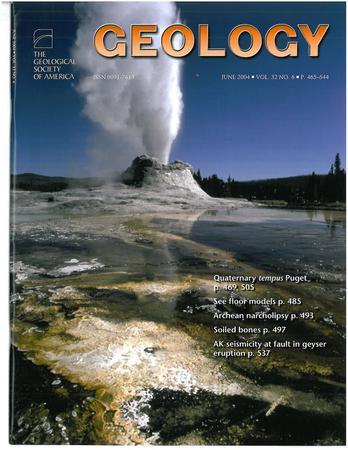Quantitative decoding of Ediacaran locomotory trace fossil morphologies: Evidence for the emergence of slender anterior-posterior body profiles
IF 4.6
1区 地球科学
Q1 GEOLOGY
引用次数: 0
Abstract
Trace fossils are vital for studying early animals and their co-evolution with paleoenvironments during the terminal Ediacaran, a period with sparse body fossil records. Thus, patterns of morphologic evolution are difficult to untangle for Ediacaran trace-makers and quantitatively unexplored. In this study, we use the integral scale, which reflects the distance within which a trajectory (i.e., force and displacement) is self-correlated, as a potential indicator for the characteristic length of trace-maker’s locomotion. By analyzing modern and fossilized animal-trace-correlated trajectories, a proportionality between the characteristic locomotory length and the trajectory integral scale is found. Since the length of the structure producing locomotion is no larger than that of the body, the characteristic locomotory length also reflects the minimal body length. Applying this scaling law to Ediacaran−Cambrian locomotory trace fossils (e.g., Archaeonassa, Gordia, Helminthopsis, Parapsammichnites), we identify clear evidence of slender anterior-posterior body axes after around 545 Ma, with gradually increasing minimal body length-to-width ratios to up to 4−12. The trace-makers probably had relatively rigid bodies with robust hydrostatic nerve-muscle systems enhancing directional sensation and movement, enabling them to thrive in dynamically complex, heterogeneous, and shifting habitats. These adaptations likely drove niche partitioning and cascading diversification, underpinning the evolutionary roots of the Cambrian Explosion and more familiar animals of the Phanerozoic. Our findings establish a novel quantitative approach to studying deep-time locomotory trace fossils, offering robust insights into early animal anatomy and paleoecological dynamics.埃迪卡拉纪运动痕迹化石形态的定量解码:细长前后身体轮廓出现的证据
微量化石对于研究埃迪卡拉末期早期动物及其与古环境的共同进化至关重要,埃迪卡拉末期是一个身体化石记录稀少的时期。因此,埃迪卡拉纪的形态进化模式很难解开,而且还没有进行定量探索。在本研究中,我们使用反映轨迹(即力和位移)自相关距离的积分尺度作为轨迹制造者运动特征长度的潜在指标。通过对现代和化石动物足迹相关轨迹的分析,发现了特征运动长度与轨迹积分尺度之间的比例关系。由于产生运动的结构的长度不大于身体的长度,因此特征运动长度也反映了最小体长。将这一比例定律应用于埃迪卡拉纪-寒武纪的运动痕迹化石(如Archaeonassa, Gordia, Helminthopsis, Parapsammichnites),我们发现了545 Ma左右后细长的前后体轴的明显证据,最小体长与宽度比逐渐增加到4 - 12。痕迹制造者可能有相对坚硬的身体,有强大的流体静力神经肌肉系统,增强方向感和运动,使它们能够在动态复杂、异质和不断变化的栖息地中茁壮成长。这些适应可能推动了生态位划分和级联多样化,为寒武纪大爆发和显生宙更熟悉的动物的进化根源奠定了基础。我们的发现建立了一种新的定量方法来研究深时间运动痕迹化石,为早期动物解剖学和古生态动力学提供了强有力的见解。
本文章由计算机程序翻译,如有差异,请以英文原文为准。
求助全文
约1分钟内获得全文
求助全文
来源期刊

Geology
地学-地质学
CiteScore
10.00
自引率
3.40%
发文量
228
审稿时长
6.2 months
期刊介绍:
Published since 1973, Geology features rapid publication of about 23 refereed short (four-page) papers each month. Articles cover all earth-science disciplines and include new investigations and provocative topics. Professional geologists and university-level students in the earth sciences use this widely read journal to keep up with scientific research trends. The online forum section facilitates author-reader dialog. Includes color and occasional large-format illustrations on oversized loose inserts.
 求助内容:
求助内容: 应助结果提醒方式:
应助结果提醒方式:


